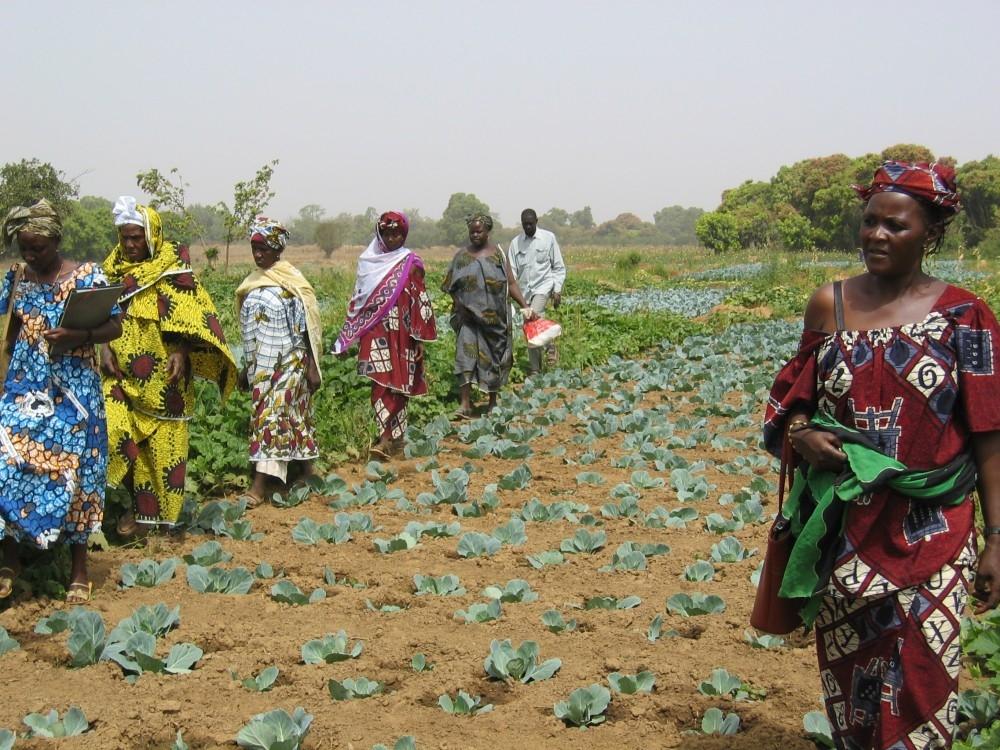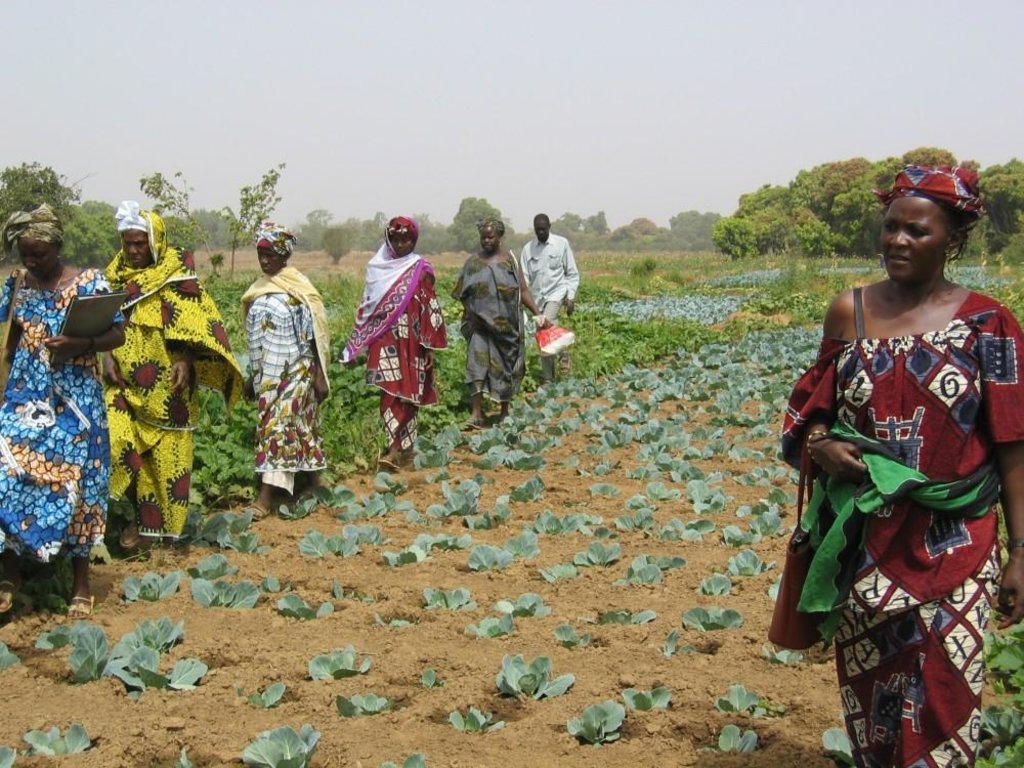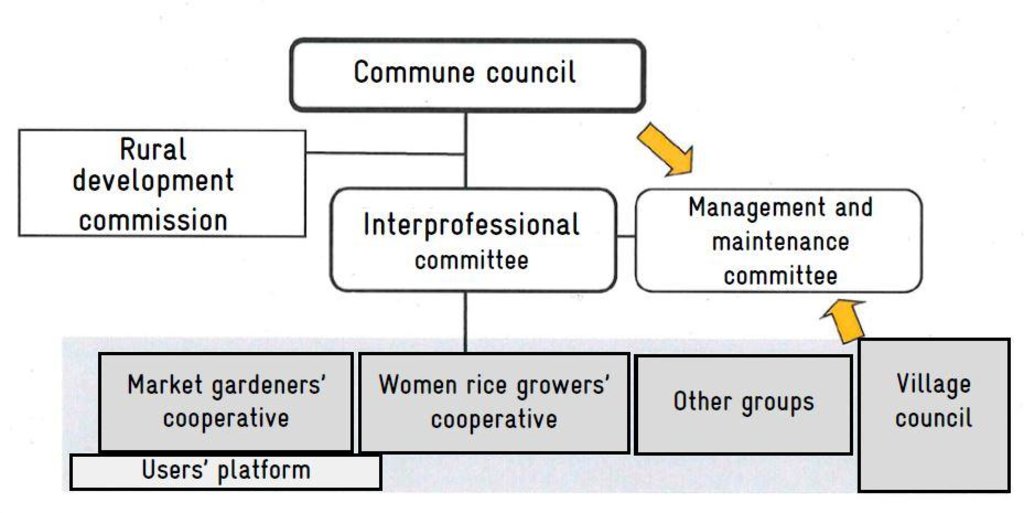Delegating the management of facilities to users [马里]
- 创建:
- 更新:
- 编制者: Dieter Nill
- 编辑者: –
- 审查者: Laura Ebneter
Délégation de gestion des équipements aux exploitants (French)
approaches_2503 - 马里
查看章节
全部展开 全部收起1. 一般信息
1.2 参与方法评估和文件编制的资源人员和机构的联系方式
SLM专业人员:
Tamini Jacques
jacques.tamini@helvetas.org
HELVETAS - Swiss Intercooperation
马里
SLM专业人员:
Doumbia Moussa
douballa03@yahoo.fr / bulonbasecom@yahoo.fr
Intercommunalité de Bougouni "Bulonba"
马里
有助于对方法进行记录/评估的机构名称(如相关)
Deutsche Gesellschaft für Internationale Zusammenarbeit (GIZ) - 德国有助于对方法进行记录/评估的机构名称(如相关)
HELVETAS (Swiss Intercooperation)1.3 关于使用通过WOCAT记录的数据的条件
(现场)数据是什么时候汇编的?:
01/07/2012
编制者和关键资源人员接受有关使用通过WOCAT记录数据的条件。:
是
2. SLM方法的描述
2.1 该方法的简要说明
Promote the sustainability and cost effectiveness of schemes by setting up management delegation systems that enable local authorities to entrust infrastructure owned by the territorial community to groups of local farmers.
2.2 该方法的详细说明
该方法的详细说明:
The basic economic infrastructure is usually provided through state or decentralised-authority funding. The building phase of the project is entirely managed by the territorial community (TC). A delegation process ensures that responsibility for managing this infrastructure is transferred to beneficiary actors organised in user associations. Agreements are concluded between the TCs and communities with the aim of guaranteeing the sustainability and economic viability of facilities. This agreement makes it possible to extend the ownership of schemes beyond that of the traditional management committee model. It can also increase local tax revenues and prolong the lifespan of facilities when they are well run.
The commune is the owner of the scheme but delegates its management to a user group (an interprofessional farming committee for lowland development projects) by means of a management delegation contract. Member subscription fees and upkeep fees are paid into a bank account opened by the community. The commune has the right to oversee the administrative and financial management of the delegatee and ensures the application of access and farming rules in the scheme. Group managers regularly report on activities to other members and the commune.
The commune council undertakes the overall project management of the installation works, contributes to funding the developments, provides key guidance on farming matters, delegates the management of the infrastructure to the interprofessional committee (IPC), supports the IPC in recovering fees, and ensures the monitoring and development of the project. The rural development commission of the commune council exists within each council. Its role is to catalogue the issues actors face and propose solutions to the commune council, support cooperatives in their search for partners together with the IPC, research the land titles for schemes on behalf of the council (registration), validate the development plan, support IPC in managing conflicts between cooperatives, and carry out any other tasks that are required of it by the commune council. The interprofessional committee brings together representatives from different cooperatives, associations and groups and takes on the delegated management role. Its role is to: maintain communications between users, the town hall and partners; coordinate activities that affect several local-level cooperatives; ensure the rational use of lowland resources; secure the agreement of the different user groups on the rules for accessing and dividing up the scheme site; assess and validate the cooperatives’ farming plans (individual needs analysis in terms of production capacity); monitor the use of inputs, seed and equipment obtained by the cooperatives; receive the fees collected by each cooperative from its members; manage renovation and maintenance funds; prevent conflicts of interest arising among the cooperatives. The management committee is a sub-committee within IPC and is tasked with managing water supply (opening and closing the distribution gates), carrying out small-scale maintenance and alerting the IPC to any failures to respect the farming code. Consultancies facilitate the process, support the institutional and organisational strengthening of actors and provide training on management tools. Technical services ensure the application of technical and environmental standards and ensure sound financial management (fee collection, financial controls, delegated public procurement). The project team provides advisory support, organises users structurally and delivers training, tools, coordination and monitoring.
2.3 该方法的照片
2.5 采用该方法的国家/地区/地点
国家:
马里
区域/州/省:
Mali
有关地点的进一步说明:
Sikasso region, circles of Bougouni, Kolondiéba and Yanfolila
2.6 该方法的开始和终止日期
注明开始年份:
2008
2.8 该方法的主要目的/目标
The Approach focused mainly on SLM with other activities
The objective of the practice is to promote the sustainability and cost effectiveness of schemes by setting up management delegation systems that enable local authorities to entrust infrastructure owned by the territorial community to groups of local farmers.
The SLM Approach addressed the following problems: lack of infrastructure for local farmers, low sustainability and cost-effectiveness of schemes
2.9 推动或妨碍实施本办法所适用的技术的条件
了解SLM,获得技术支持
- 阻碍
The basic economic infrastructure is usually provided through state or decentralised-authority funding.
Treatment through the SLM Approach: A delegation process ensures that responsibility for managing this infrastructure is transferred to beneficiary actors organised in user associations with the aim of guaranteeing the sustainability and economic viability of facilities.
3. 相关利益相关者的参与和角色
3.1 该方法涉及的利益相关者及其职责
- 当地土地使用者/当地社区
- SLM专家/农业顾问
- 地方政府
- 国家政府(规划者、决策者)
3.2 当地土地使用者/当地社区参与该方法的不同阶段
| 当地土地使用者/当地社区的参与 | 指定参与人员并描述活动 | |
|---|---|---|
| 启动/动机 | 互动 | |
| 计划 | 互动 | |
| 实施 | 互动 | |
| 监测/评估 | 互动 | |
| Research | 被动 |
3.3 流程图(如可用)
具体说明:
The measure relies on the direct actors shown in the diagram, who are supported by other stakeholders. From the start of installation works, the commune supports the project in setting up a management system. Installation works are co-funded by the technical and financial partners (TFP), communes and beneficiary villages. It must nevertheless be highlighted that the infrastructure remains the property of the commune and beneficiaries must pay a fee for its upkeep. The commune selects the consultancy (project manager) and chooses the contractor. The commune also Monitors scheme installation and accepts works. A second consultancy is tasked with giving producers guidance on farming and management techniques. The different user groups (market gardeners/planters, women rice growers, livestock farmers, etc.) are formed into interprofessional committees or farming committees. The commune draws up the draft delegated management contract with the interprofessional committee or the cooperative. To this end, it evaluates the potential of the resources that can be mobilised and discusses with its partners the rules for farming the scheme and the methods for its maintenance and repair. Following this, the contract is signed.
3.4 有关SLM技术选择的决策
具体说明谁有权决定选择要实施的技术:
- 主要是土地使用者,由SLM专家提供支持
解释:
Decisions on the method of implementing the SLM Technology were made by mainly by land users supported by SLM specialists
4. 技术支持、能力建设和知识管理
4.2 咨询服务
土地使用者有权使用咨询服务吗?:
是
指明是否提供了咨询服务:
- 在固定中心
说明/注释:
Advisory service is quite adequate to ensure the continuation of land conservation activities; Setting up this system requires ongoing support for two to five years to allow beneficiaries to take ownership of the scheme.
4.3 机构强化(组织发展)
是否通过这种方法建立或加强了机构?:
- 是,适度
具体说明机构的强化或建立程度:
- 本地
具体说明支持类型:
- 财务
4.4 监测和评估
监测和评估是该方法的一部分吗?:
是
注释:
technical aspects were ad hoc monitored by project staff, land users through observations
socio-cultural aspects were ad hoc monitored by project staff, land users through observations
economic / production aspects were ad hoc monitored by project staff, land users through measurements
There were no changes in the Approach as a result of monitoring and evaluation
There were no changes in the Technology as a result of monitoring and evaluation
4.5 研究
研究是该方法的一部分吗?
是
明确话题:
- 社会学
- 经济/市场营销
- 生态学
- 技术
5. 融资和外部物质支持
5.1 该方法中SLM组成部分的年度预算
注释(例如主要的资助来源/主要捐助者):
Approach costs were met by the following donors: private sector (technical and financial partners (TFP)): 85.0%; local government (district, county, municipality, village etc) (commune): 10.0%; local community / land user(s) ( village): 5.0%
5.2 为土地使用者提供财政/物质支援
土地使用者是否获得实施该技术的财政/物质支持?:
是
如果是,请具体说明支持的类型、条件和提供者:
Installation works are co-funded by the technical and financial partners (TFP), communes and beneficiary villages. In small-scale irrigation projects, for example, the project provides up to 85% of the funds; the village 5% and the commune 10%. The beneficiaries contribute either in-kind or financially.
5.3 对特定投入的补贴(包括劳动力)
如果土地使用者的劳动力是一项重要的投入,那么是不是:
- 自愿
6. 影响分析和结论性陈述
6.1 方法的影响
该方法是否帮助土地使用者实施和维护SLM技术?:
- 否
- 是,很少
- 是,中等
- 是,支持力度很大
Consensually agreed farming codes and rules are instituted and monitored. Agreements are concluded between the TCs and communities with the aim of guaranteeing the sustainability and economic viability of facilities.
该方法是否有助于社会和经济弱势群体?:
- 否
- 是,很少
- 是,中等
- 是,支持力度很大
Did other land users / projects adopt the Approach?
- 否
- 是,很少
- 是,中等
- 是,支持力度很大
The system was first initiated and developed at 34 commercial infrastructure trade fairs. Today, it involves 15 farming sites. The practice has been applied since 2008.
Did the Approach lead to improved livelihoods / human well-being?
- 否
- 是,很少
- 是,中等
- 是,支持力度很大
In the Bougouni area, 552 hectares are being farmed by 1,671 rice growers, 80% of whom are women. Production has increased for 70% of growers. The principle of a maintenance fund has been accepted and is now operational, with deposits ranging from 75,000 to 300,000 CFA francs per year
Did the Approach help to alleviate poverty?
- 否
- 是,很少
- 是,中等
- 是,支持力度很大
6.2 土地使用者实施SLM的主要动机
- 增加生产
- 增加利润(能力),提高成本效益比
6.3 方法活动的可持续性
土地使用者能否维持通过该方法实施的措施(无外部支持的情况下)?:
- 不确定
若否或不确定,请具体说明并予以注释:
Setting up this system requires ongoing support for two to five years to allow beneficiaries to take ownership of the scheme.
6.4 该方法的长处/优点
| 编制者或其他关键资源人员认为的长处/优势/机会 |
|---|
| Many repairs are already being handled by the delegated management structures. These structures ensure that the consensually agreed rules are appropriately applied. A new kind of partnership has been created between the local authorities and village communities. |
|
It can increase local tax revenues and prolong the lifespan of facilities when they are well run. How to sustain/ enhance this strength: The commune authorities must be willing to promote transparency in communications on works procurement and accept requests for clarification (public audits). The community must have leaders in place who are prepared to lead frank public discussions among key players that are also courteous and respectful. This also applies to the management committee. Monitoring and evaluation of the delegation contract is essential between the commune and platform. It is important to undertake an annual review, the conclusions of which will also be shared with the wider community. To do this, the management committee must be in a position to draw up a balance sheet. The village must be prepared to contribute (with their labour or funds) towards installing the scheme, prior to registering it in the PDESC. It is essential to remove any ambiguity from bylaws for the scheme belonging to the commune. If it is true that actors rarely challenge the old, established rules for accessing rice growing sites, the same cannot be said for market gardens, where the plot allocation rules fall easily into place. Growers must pay the amounts/fees agreed with the commune.) |
| Subscription fees are collected more easily: 84% of members pay their subscription fees for the area in question. Consensually agreed farming codes and rules are instituted and monitored. In the Bougouni area, 552 hectares are being farmed by 1,671 rice growers, 80% of whom are women. Production has increased for 70% of growers. The principle of a maintenance fund has been accepted and is now operational, with deposits ranging from 75,000 to 300,000 CFA francs per year. |
7. 参考和链接
7.1 方法/信息来源
- 实地考察、实地调查
- 与土地使用者的访谈
7.2 参考可用出版物
标题、作者、年份、ISBN:
Manual of Good Practices in Small Scale Irrigation in the Sahel. Experiences from Mali. Published by GIZ in 2014.
可以从哪里获得?成本如何?
http://star-www.giz.de/starweb/giz/pub/servlet.starweb
标题、作者、年份、ISBN:
Rapport appui à la valorisation des ouvrages hydroagricoles [Report on supporting the development of small-scale irrigation schemes], GSAD, June 2012
标题、作者、年份、ISBN:
Annual report: Monitoring lowland areas, BEACIL, June 2012
链接和模块
全部展开 全部收起链接
无链接
模块
无模块




